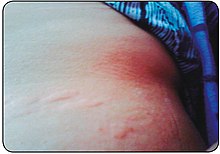Benznidazole
[4][5] Rare side effects include bone marrow suppression which can lead to low blood cell levels.
[7] As of 2012, Laboratório Farmacêutico do Estado de Pernambuco, a government run pharmaceutical company in Brazil was the only producer.
[6] Some studies indicate treatment with benznidazole during the chronic phase, even if incapable of producing parasitologic cure because it reduces electrocardiographic changes and delays worsening of the clinical condition of the patient.
[11] Children are found to be at a lower risk of adverse events compared to adults, possibly due to increased hepatic clearance of the drug.
[16] Other adverse reactions include anorexia, weight loss, nausea, vomiting, insomnia, and dysgeusia, and bone marrow suppression.
[14] Benznidazole is a nitroimidazole antiparasitic with good activity against acute infection with Trypanosoma cruzi, commonly referred to as Chagas disease.
[14] Like other nitroimidazoles, benznidazole's main mechanism of action is to generate radical species which can damage the parasite's DNA or cellular machinery.
[17] In mammals, the principal mediators of electron transport are NAD+/NADH and NADP+/NADPH, which have a more positive reduction potential and so will not reduce nitroimidazoles to the radical form.
[18] In mammals, these radicals can be converted safely to hydrogen peroxide, meaning benznidazole has very limited direct toxicity to human cells.
[20] 5% of the parent drug is excreted unchanged in the urine, which implies that clearance of benznidazole is mainly through metabolism by the liver.
[20] Benznidazole and other nitroimidazoles have been shown to decrease the rate of clearance of 5-fluorouracil (including 5-fluorouracil produced from its prodrugs capecitabine, doxifluridine, and tegafur).
[23] The GLP-1 receptor agonist lixisenatide may slow down the absorption and activity of benznidazole, presumably due to delayed gastric emptying.
